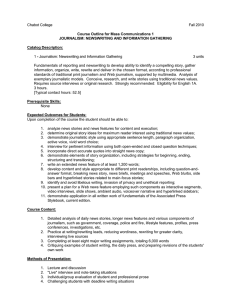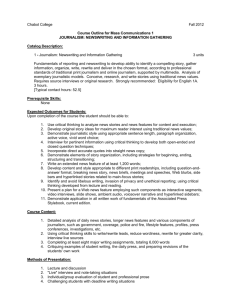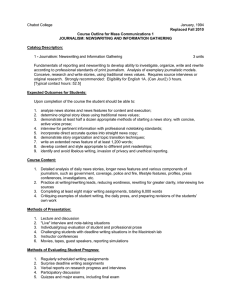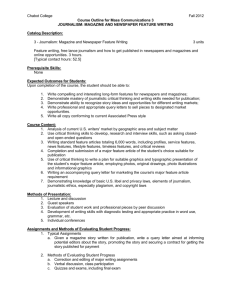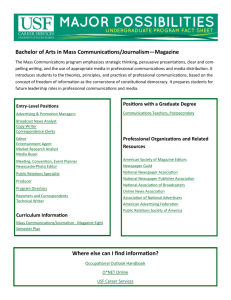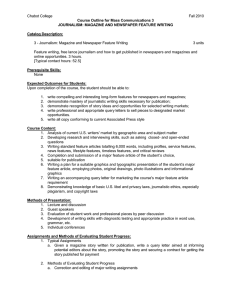College of San Mateo Course Outline
advertisement
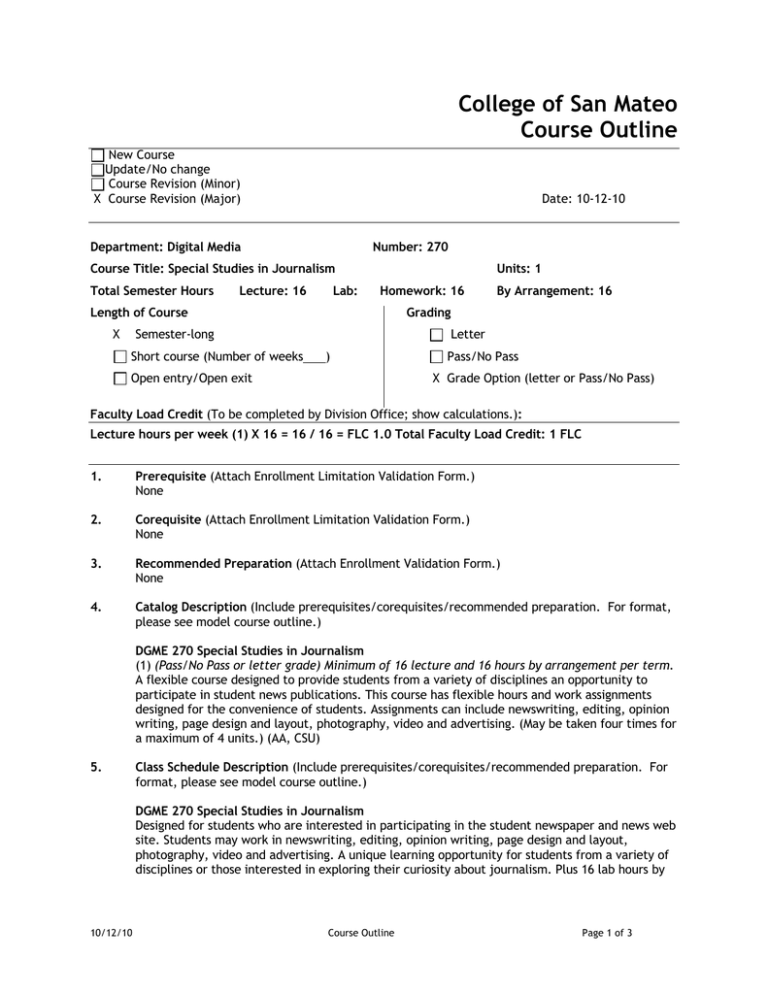
College of San Mateo Course Outline New Course Update/No change Course Revision (Minor) X Course Revision (Major) Date: 10-12-10 Department: Digital Media Number: 270 Course Title: Special Studies in Journalism Total Semester Hours Lecture: 16 Lab: Units: 1 Homework: 16 Length of Course X Grading Semester-long Short course (Number of weeks By Arrangement: 16 Letter ) Pass/No Pass X Grade Option (letter or Pass/No Pass) Open entry/Open exit Faculty Load Credit (To be completed by Division Office; show calculations.): Lecture hours per week (1) X 16 = 16 / 16 = FLC 1.0 Total Faculty Load Credit: 1 FLC 1. Prerequisite (Attach Enrollment Limitation Validation Form.) None 2. Corequisite (Attach Enrollment Limitation Validation Form.) None 3. Recommended Preparation (Attach Enrollment Validation Form.) None 4. Catalog Description (Include prerequisites/corequisites/recommended preparation. For format, please see model course outline.) DGME 270 Special Studies in Journalism (1) (Pass/No Pass or letter grade) Minimum of 16 lecture and 16 hours by arrangement per term. A flexible course designed to provide students from a variety of disciplines an opportunity to participate in student news publications. This course has flexible hours and work assignments designed for the convenience of students. Assignments can include newswriting, editing, opinion writing, page design and layout, photography, video and advertising. (May be taken four times for a maximum of 4 units.) (AA, CSU) 5. Class Schedule Description (Include prerequisites/corequisites/recommended preparation. For format, please see model course outline.) DGME 270 Special Studies in Journalism Designed for students who are interested in participating in the student newspaper and news web site. Students may work in newswriting, editing, opinion writing, page design and layout, photography, video and advertising. A unique learning opportunity for students from a variety of disciplines or those interested in exploring their curiosity about journalism. Plus 16 lab hours by 10/12/10 Course Outline Page 1 of 3 arrangement. May be taken four times for a maximum of four units. (Pass/No Pass or letter grade) (AA, CSU) 6. Student Learning Outcomes (Identify 1-6 expected learner outcomes using active verbs.) Upon successful completion of the course, the student will be able to: 1. Demonstrate familiarity with the requirements for producing a student publication. 2. Evaluate media industries for further study or career objectives. 7. Course Objectives (Identify specific teaching objectives detailing course content and activities. For some courses, the course objectives will be the same as the student learning outcomes. In this case, “Same as Student Learning Outcomes” is appropriate here.) Same as Student Learning Outcomes. 8. Course Content (Brief but complete topical outline of the course that includes major subject areas [1-2 pages]. Should reflect all course objectives listed above. In addition, a sample course syllabus with timeline may be attached.) Digital Media 270 is a one-unit, non-transferable course designed to provide a flexible learning opportunity for those students who are interested in gaining journalism experience without the time commitments required by current program offerings. Students from other disciplines are welcome to participate in publication of the campus newspaper within their preferred field of study or interest. Areas for participation include newswriting, editing, opinion writing, page design and layout, photography and advertising. Examples: A Business student could participate by engaging in advertising sales for the newspaper; a Photography student could participate by performing photography for the newspaper; a Technical Arts and Graphics student could learn by performing page design for the newspaper. Students will become knowledgeable about legal and ethical standards in journalism, and how the structure and decision-making for news publications is developed and applied. Students will learn to work collaboratively in a structured environment as provided by the editorial hierarchy of the campus newspaper. Students will meet in the campus newspaper office and then may engage in field work, such as advertising solicitation. Students will analyze the fundamental elements of journalism, incluiding legal and ethical issues, during classroom sessions. Work assignments will be flexible and based on the student's preferred field of study or interest. 9. Representative Instructional Methods (Describe instructor-initiated teaching strategies that will assist students in meeting course objectives. Describe out-of-class assignments, required reading and writing assignments, and methods for teaching critical thinking skills. If hours by arrangement are required, please indicate the additional instructional activity which will be provided during these hours, where the activity will take place, and how the activity will be supervised.) The instructor will lecture and lead group discussions during class sessions about fundamental elements in journalism performance. Students will be advised by the instructor in completing assignments for the student publication. Student work will be published or otherwise incorporated into publication production within the existing student-run editorial structure. For hours by arrangement, students will participate in the laboratory sessions or field assignments for publication production within a schedule that accommodates their availability, under faculty supervision. 10/12/10 Course Outline Page 2 of 3 10. Representative Methods of Evaluation (Describe measurement of student progress toward course objectives. Courses with required writing component and/or problem-solving emphasis must reflect critical thinking component. If skills class, then applied skills.) Grading will be based on: • Participation in class discussions and performing specific duties in connection with student publications as designed per the student's current major or interest • Demonstrated progress as evaluated by the student's timely completion of assignments, and application of class lessons, critiques and coaching in improving his or her work as demonstrated in published form • Thoroughness and timely completion of assignments as demonstrated in published form, with evidence of application of in-class lessons to published work. Students also will provide a final essay reviewing legal and ethical standards in journalism as presented during class and laboratory sessions 11. Representative Text Materials (With few exceptions, texts need to be current. Include publication dates.) Associated Press Style Book and Libel Manual 2009, Addison-Wesley Publishing Co., Inc. The Elements of Style: 50th Anniversary Edition, by William Strunk Jr. and E.B. White, Macmilllan Publishing Co., Inc., 2008 Students also are provided a copy of the program's operations and ethics guide, The San Matean Manual. These materials are available in the classroom library. Prepared by: (Signature) Email address: Submission Date: 10/12/10 Course Outline Page 3 of 3

